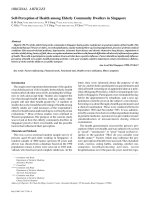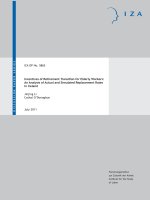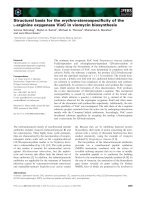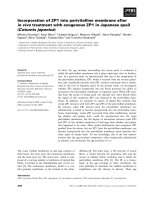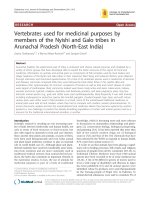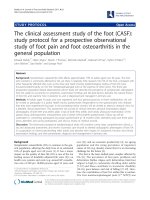Politicised nationality for transnational life simultaneous incorporation of mainland chinese settled student migrants in singapore
Bạn đang xem bản rút gọn của tài liệu. Xem và tải ngay bản đầy đủ của tài liệu tại đây (1.01 MB, 145 trang )
POLITICISED NATIONALITY FOR
TRANSNATIONAL LIFE:
SIMULTANEOUS INCORPORATION OF MAINLAND
CHINESE SETTLED STUDENT MIGRANTS IN
SINGAPORE
LIM JIALING
(B.Soc.Sc. (Hons.), NUS
A THESIS SUBMITTED
FOR THE DEGREE OF MASTER OF SOCIAL
SCIENCES
DEPARTMENT OF SOCIOLOGY
NATIONAL UNIVERSITY OF SINGAPORE
2011
ACKNOWLEDGEMENTS
This thesis will not be possible without the help and support from the following
people.
First, I thank my thesis advisor, Dr. Mika Toyota for her kind guidance and
insightful comments throughout the progress of the thesis. I also thank Dr. Ho
Kong Chong and Dr. Vincent Chua for their friendly advice during the
preliminary stage of the research. I would also like to express my gratitude to Ms
Raja from the Sociology department for rendering administrative assistance
throughout the entire period of candidature.
I am extremely grateful to all informants who took the time to meet me and share
with me their experiences as student migrants in Singapore. It has been a great
pleasure to meet these lovely individuals and I wish them all the best in their
future endeavours.
Special thanks are extended to Sharifah, Baogang, Max, Zhengyi, Qiongyuan and
Si Bing for their selfless help in locating informants for the research.
The journey has been less lonely because of fellow graduate students who have
offered various forms of academic and emotional support. I have benefitted
greatly and will miss dearly both formal discussions and informal conversations. I
thank especially Wei Da, Sarada, Ge Yun, Hu Shu, Hui Hsien, Seung Eun,
Qiongyuan, Li Hui, Zhengyi, Minghua, Pamela, Allan, Hafizah, Fadzli, Ryan,
Fiona, Keith, Eugene, Daniel and Thomas.
I am also immensely grateful to Qiao, Janice, Xuebao, Qian, Nalin and Regina for
their precious friendship and unwavering support over the years.
Last but not least, I am forever indebted to my family – my parents and especially
my sister and best friend, Joanne for her companionship and encouragement
during this endeavour. I also thank Aunt Yanliu and Uncle Jia for their hospitality
during my overseas fieldwork in China.
ii
TABLE OF CONTENTS
Acknowledgements
ii
Table of Contents
iii
Summary
vi
List of Illustrations
Chapter 1
viii
1
Introduction: International student migration, skilled migration and
migrant incorporation
1.1 The concept of incorporation
3
1.2 Ethnic focus in the student migration literature
7
1.3 Method
13
1.4 Thesis argument and overview
20
Chapter 2
24
Transnationalism and the role of the nation-state
2.1 Transnationalism framework: student migrants as transmigrants
24
2.2 Transnationalism and ethnicity
30
2.3 Transnationalism and the nation
33
2.4 Conclusion: Reconceptualising the role of the nation-state in
36
transnationalism
iii
Chapter 3
38
Singapore as a study-work destination: establishing migrant and state
motivations
3.1 Student migrants: Studying for employment in Singapore
38
3.2 Singapore as receiving country: ‘Ethnicised’ Singapore and its
46
population challenge
3.3 State policies with a China orientation
48
3.4 Conclusion: Ethnicity versus nationality of the student migrant
59
Chapter 4
61
Salience of nationality I: State-market construction of human-cultural
capital
4.1 State discourse: the value of Mainland Chinese student migrants
61
4.2 Human-cultural capital for employment
70
4.3 Conclusion: Privileging nationality for structural incorporation
78
Chapter 5
80
Salience of nationality II: Migrants’ construction of cultural
difference
5.1 Identification of “national” cultures
80
5.2 “Not completely integrated but adjusted”: Cultural dissonance and
88
political constructions of difference
5.3 Dis-reifying “national” cultures
96
iv
5.4 Structurally-induced perceptions of difference
101
5.5 Conclusion: Privileging nationality for socio-cultural incorporation
102
Chapter 6
104
Conclusion: Politicised nationality for transnational life
6.1 Key conclusions
105
6.2 Theoretical contribution to the literature
110
6.3 Limitations and directions for future research
113
6.4 The nation-state in a transnational world
116
Bibliography
118
Appendix A
130
Appendix B
132
v
SUMMARY
Student migration constitutes an important part of globalisation in general, and in
Asia Pacific in particular. As a typical “transnational” phenomenon, student
migration has been widely analysed from the predominant perspective of
transnationalism. According to this approach, students’ international mobility
should not be examined in either sending or receiving countries alone as the
students’ social networks, life experiences and especially future strategies are no
longer confined to particular countries. The students are flexible citizens and
global subjects in the making. In the transnational paradigm, factors that are not
bound by national borders such as culture, identity and capital are highlighted,
while the nation-state is relativised. In the case of student migration, and the
subsequent settlement of the students as skilled migrants, ethnicity is regarded as
a particularly important factor in facilitating their mobility. The Singaporean state
implicitly and explicitly stresses that students and subsequently professionals
from China are desirable because they share the same ethnic background as the
majority of the Singaporean citizens. The students are expected to become
transnational Chinese with a firm ethnic affinity but a relative loose national
identity.
Built on the existing literature on transnationalism and my own empirical
research, this thesis suggests that the Mainland Chinese students follow a pattern
of “simultaneous incorporation” in the sense that they are incorporated, but not
completely assimilated, into the local Singaporean society, while at the same time
vi
maintain transnational ties to China. More importantly, however, this thesis
argues that in transnational simultaneous incorporation, ethnicity does not play as
big a role as it is normally assumed. Instead nation-state remains a predominant
framework under which the students form their identity and interact with
Singaporean society. As such this thesis will not only provide new information
about student migration, but will also contribute to general theoretical discussion
in migration studies, particularly by highlighting the complex intersections
between the national and the transnational.
The thesis addresses these questions primarily based on narrative analysis on the
Singaporean media representation on Mainland Chinese student migration and the
students’ reflections on their experiences. While the former was conducted
through an analysis of media discourse, the latter was carried out by interviewing
currently enrolled Chinese students, former students who now reside in
Singapore, and those who return to China. By bringing together the voices of the
informants who are at different stages of their migratory trajectory and are in
different countries, I will demonstrate how exactly the nation-state is constructed
as the predominant identity marker in the transnational context, and how this
nation-based identity is in fact fraught with contradictions. In sum, the thesis does
not claim to assess how well or poorly the students are incorporated into
Singaporean society, but instead aims to delineate the cultural logic of their
identity negotiation in a cross-border context.
vii
LIST OF ILLUSTRATIONS
Illustration 3.1 Advertisement board in Shanghai for private education
institution in Singapore
52
Illustration 3.2 Advertisement board for private education institution in
Singapore
53
viii
CHAPTER 1
Introduction: International student migration, skilled migration and migrant
incorporation
Cross-country student migration – the act of migration or mobility for the pursuit
of education – is a growing phenomenon related to the internationalisation of
education that has seen not only an increase in the number of international
students worldwide but also an expanding range of sending and receiving
countries. According to the Global Education Digest 2009 published by the
UNESCO Institute for Statistics, the year 2007 has seen the number of
international students enrolled in foreign educational institutions exceed 2.8
million, which is a 53 per cent increase in the number of mobile students
worldwide since 1999.
The thesis focuses on the student migration trajectory from Mainland China1 to
Singapore which is primarily significant for reflecting two emerging
developments – a greater dispersion of mobile students and an increased tendency
of mobile students to remain within their regions of origin (UNESCO- IS 2009). It
was reported in 2005 that the number of students from China estimated at 33,000
have surpassed the number of students from Malaysia and Indonesia (both
estimated at 8,000) which used to form the largest group of foreign students in
Singapore (Straits Times (ST) 3 December 2005). They can be observed to pursue
1
This thesis refers primarily to students from Mainland China because it excludes consideration of
students from the Chinese territories of Macau and Hong Kong. People’s Republic of China (PRC)
or China will be used when making a reference to the nation-state entity of the student migrant.
1
studies at various levels of the education system from primary to tertiary
education and in both public and private education sectors.
More importantly, the specific student migration trajectory from Mainland China
to Singapore has been imbued with greater significance as it leads to skilled
migration, that is, a large proportion of students who complete their high
education in Singapore stay on to work and live there on various forms of
immigrant statuses such as work pass, and permanent resident status. A sizable
number of them have acquired Singaporean citizenship.
The fact that former students become residents does not necessarily mean that
they have become an indistinguishable part of Singaporean society and cut off
their connections with China. Built on the existing literature on transnationalism
and empirical research, this thesis suggests that the Chinese students follow a
pattern of “simultaneous incorporation” in the sense that they are incorporated,
but not completely assimilated, into the local Singaporean society, while at the
same time maintain transnational ties to China. More importantly, this thesis
argues that in transnational simultaneous incorporation, ethnicity does not play as
big a role as it is normally assumed. Instead nation-state remains a predominant
framework under which the students form their identity and especially interact
with the Singaporean society. As such this thesis will not only provide new
information about student migration, but also contribute to general theoretical
2
discussion in migration studies, particularly by highlighting the complex
intersections between the national and the transnational.
The thesis addresses these questions primarily through narrative analysis on the
Singaporean media representation on Chinese student migration and the students’
reflections on their experiences. While the former was conducted through an
analysis of media discourse, the latter was carried out by interviewing currently
enrolled Chinese students, former students who now reside in Singapore, and
those who return to China. By bringing together the voices of the informants who
are at different stages of their migratory trajectory and are in different countries, I
will demonstrate how exactly the nation-state is constructed as the predominant
identity marker, and how this nation-based identity is in fact fraught with
contradictions. In sum, the thesis does not claim to assess how well or poorly
Chinese students are incorporated into Singaporean society, but instead aims to
delineate the cultural logic of identity negotiation.
The introductory chapter will be organised this way. The key concept of
incorporation will be clarified, followed by a discussion of the existing literature
with its privileging of ethnicity over nationality in discussing transnational
migration in general, and student migration in particular.
1.1 The concept of incorporation
Before proceeding, an elaboration of the concept of ‘incorporation’ is necessary.
Glick Schiller and Çağlar have used the term ‘incorporation’ to speak of the
3
“networks that link migrants to institutions within and across the borders of
nation-states” (2009: 179). In the same way, this thesis engages with the notion of
incorporation to allude to the embeddedness of the migrant within social
processes that are not restricted to the boundaries of the receiving country. A
conceptual distinction
should also
be established between the
terms
‘incorporation’, ‘integration’ and ‘assimilation’ which have sometimes been used
interchangeably in everyday life to refer to the settlement of migrants into the host
society. These terms are arguably steeped in connotations, being characterised by
political discourses of particular nation-states (Glick Schiller and Çağlar 2009),
though ‘incorporation’ is considered to contain less political undertones
(Schmitter Heisler 1992; Portes 1995). Some terms also contain greater
significance in the scholarship for the conceptual baggage that they have come to
carry. Most notably, ‘assimilation’ has lost academic currency with its roots
traced to the assimilation model that entails a unidirectional and eventual process
of complete integration of a subordinate minority into a dominant majority. In
contrast, ‘incorporation’ is commonly used by transnational migration scholars to
distinguish from the concept of assimilation. This thesis therefore adopts the term
‘incorporation’ to counter the notion of imposition on the minority by the majority
and indicate a degree of agency of migrant actors in incorporating themselves into
the host society. Rid of notions of eventuality and totality, incorporation suggests
most importantly that migrants are no longer required to discard their cultural
traits for life in the receiving country.
4
Incorporation also needs to be understood as consisting of differing patterns,
modes or pathways that vary according to the interaction between the migrant and
the context. For instance, Nee and Sanders (2001) identify the existence of a
variety of modes of incorporation that are substantially determined by the type
and level of capital owned and subsequently acquired by immigrants and their
family in any particular context. Similarly, Glick Schiller and Çağlar (2009)
identify various pathways of migrant incorporation that are both influenced by
and affect the global position of cities. Above all, these accounts suggest that the
particular mode of incorporation of student migrants needs to take into
consideration the interaction between their possession of capital and their location
within larger political, economic and social processes.
Moreover, incorporation should be appreciated as a multifaceted notion that
comprises economic, political, cultural or psychological dimensions. I focus the
analysis along two particular dimensions – structural or socio-economic on the
one hand and cultural on the other. Structural aspect of incorporation can be
considered in relation to the level of educational attainment and employment
status of the migrant while the cultural dimension considers migrant’s casual ties
to locals and their acceptance of cultural norms or values of the receiving society
(Snel, Engbersen, and Leerkes 2006). Together, the two dimensions come close to
providing a near-comprehensive account of the multi-dimensional concept of
incorporation. Although the structural and socio-cultural dimensions are
distinguished as such, they are not to be conceived as independent of one another
5
since for instance, the adoption of local norms may constitute an asset in the
workplace.
Simultaneity of incorporation
Conceptions of models of assimilation and multiculturalism remain restricted by
the borders of nation-states and entrenched within the language of race or ethnic
relations due in large part to the proliferation of immigration studies focused on
the racial or ethnic minorities in the United States. Although we note a positive
shift towards an interactive process between immigrants and the receiving society,
inherent to these theories is the taken-for-granted isomorphism between people
and nation. Theorising efforts “from the Chicago school's assimilationism through
multiculturalism to contemporary neo-assimilationism - all presuppose that the
relevant entities to be related are a nation-state society on the one hand and
immigrants coming from outside this nation-state society on the other” (Wimmer
and Schiller 2003: 584). Efforts to transcend the constraints of bounded thinking
have seen the rise of the notion of simultaneous incorporation. In essence,
simultaneity in incorporation has been proposed as a mode of immigrant
incorporation that captures the sense of host country incorporation that takes place
concurrently with the maintenance of ties to the sending country. According to
Levitt and Glick Schiller (2004: 1003), simultaneity refers to “living lives that
incorporate daily activities, routines, and institutions located both in a destination
country and transnationally”. Compared to previous models of immigrant
6
incorporation, Levitt and Glick Schiller (2004) privilege the simultaneity of
connections:
[I]t is more useful to think of the migrant experience as a kind of gauge which,
while anchored, pivots between a new land and a transnational incorporation.
Movement and attachment is not linear or sequential but capable of rotating back
and forth and changing direction over time. The median point on this gauge is not
full incorporation but rather simultaneity of connection. Persons change and
swing one way or the other depending on the context, thus moving our
expectation away from either full assimilation or transnational connection but
some combination of both (P. 1011).
The notion of simultaneous incorporation challenges the traditional assimilation
model that assumes the eventual and complete assimilation of immigrants in the
receiving society. No longer should we treat migrants as individuals who uproot
themselves from the sending society to relocate in the receiving society without
sustaining social relationships with the sending society. The conception of
transnationalism which arose out of observations that immigrants continue to
maintain connections with their country of origin through cross-border activities
or identifications after settlement in the receiving society, represents an
alternative framework for understanding incorporation patterns as practiced by
transmigrants.
1.2 Ethnic focus in the student migration literature
Although international movements for the pursuit of education have been going
on for quite some time, student migration had received scant attention by scholars
as it was neither featured in extensive summaries of migration tides around the
world (Cohen 1995; Strikwerda 1999) nor a central phenomenon in theorizing
efforts (Brettell and Hollifield 2008). On some of the rare occasions when student
7
migration was mentioned (see Skeldon 1997; Castles and Miller 1998), student
migration was only accorded brief and broad discussion (King and Ruiz-Gelices
2003). The heightened expansion in magnitude and scope of student mobility in
recent years had called for more academic attention to the phenomenon,
examining for instance “student migration as a sociocultural process” and
“patterns of student migration” (King and Ruiz-Gelices 2003: 230). Contrary to
earlier scholarship that did not adequately problematise the internationalisation of
education by critically examining its effects and links to larger issues, recent
scholarship have built upon the deficiencies of earlier scholarship to examine
international education at the levels of the individual, family and national, as well
as considering factors such as social class (Collins 2008). In particular, I discuss a
number of notable works that underscore the role of ethnicity in their discussions
of motivations and lived experiences of student migrants.
1.21 Ethnic-based capital accumulation and cultural competency
Notions of “capital accumulation” and “cultural competence” have largely
focused on the role of ethnicity in the transcendence of nation-states. A theory of
capital accumulation has been used to explain the migratory movement of rich
middle-class Chinese families centred upon the education of the child.
Recognising the growing relationship between education and migration from Asia
to North America, Australia and New Zealand, the notion of cultural capital
developed from Bourdieu’s (1986) ideas constitutes the principal motivation for
migration from East Asia to Pacific Rim cities, which is perceived to grant access
8
to cultural and social capital through an overseas education experience (Ong 1999;
Waters 2005).2 Elsewhere, Lee and Koo (2006) refer to the ascendency in value
attributed to English fluency for the future workforce as one of the primary
motivations for an overseas education for the Korean children. The importance
attributed to an overseas education exists in the context of a pervasive view in
Hong Kong, Taiwan, South Korea, Singapore, Malaysia and increasingly, the
People’s Republic of China that overseas academic credentials are preferred by
employers (Waters 2006, 2007). Overseas academic credentials translate
predominantly to a form of ‘Western’ cultural capital although the term ‘Western’
is a no less problematic reference to the acquisition of academic and social
knowledge from North America, United Kingdom, Australia or New Zealand.
Nevertheless, perceptions of cultural incompetence by the receiving society
represent structural or social limits to the acquisition of ‘Western’ cultural capital
that reinforce the workings of bounded cultural conceptions.3 According to Ong
(1999), some immigrants continue to be perceived as culturally inept by the
receiving society due to the divergence between their personal features and their
possession of cultural capital. The persistent view of immigrants as inseparable
from their racial identities by the receiving societies finds support in Collins’
(2006) study which found that media portrayals of North-East Asian students in
2
Bourdieu (1986) posits the existence of capital in three fundamental forms: economic, cultural
and social with cultural and social capital transformable into economic capital under specific terms.
3
Other factors that may complicate the strategy of capital accumulation are poor academic
performance of the child who may end up acquiring less-desired cultural attitude to life and work
beyond the desired Western education and harmful social consequences due to absent parents
(Waters 2003).
9
Auckland, New Zealand tend to group disparate groups of students under a
particular racial identity that typecast them with certain economic, cultural and
social characteristics. The ‘othering’ of the Asian student with the associated
stereotypes have created problems for the interaction between Asian students and
the local population, which runs contrary to the official claim to foster
relationships with the world through international education (Collins 2006).
The way racial or cultural origins of immigrants impede the strategy to acquire
desired capital in the Western receiving societies connects with the issue of
reception of immigrants. Although Ong (1999) has consequently suggested that
ethnic Chinese who exercise flexible citizenship may receive better acceptance in
certain countries over others, the question of which countries are able to accept
the amalgamation of the racialised immigrant with the appropriate symbolic
capital hints of the need for further study. While perceived cultural
incompatibility in Western receiving societies has been raised, the perception of
cultural competence in other contexts beyond an East-West dichotomy has not
been duly addressed. Moreover, the question of how the cultural capital theory
can rationalise the decline or loss of cultural capital associated with the country of
origin deserves further comment. Admittedly, Ong (1999: 91) makes a brief
reference to this issue when she asserts that “loss and debit” must accompany
“accumulation and credit”. In all, what are considered bonus or deficit, who
perceives them this way, and in what settings are they so perceived are questions
that require detailed discussion. Waters’ (2004, 2005) discovery of a
10
geographically specific route between Hong Kong and Vancouver is notably a
progress towards understanding how the acquired cultural capital is perceived
between the two locales. Clearly, the reception of acquired cultural capital is a
complicated process that is substantially shaped by the way cultural capital is
perceived in a given site. While studies have portrayed a strong sense of cultural
proficiency defined and demarcated by racial or ethnic identity, more empiricism
is needed to specify and elucidate the terms on which cultural capital is achieved
and mobilised.
Relatedly, discussions of capital accumulation have been tied to the notion of
social class reproduction centred on the family as the analytical unit. Establishing
a relationship between education and the family unit, Waters (2005) contends that
the conceptualisation of overseas education should not be divorced from a larger
familial strategy to acquire capital. The ‘astronaut family’ arrangement practiced
by immigrants from Hong Kong in Canada prominently represents a household
strategy to acquire various forms of capital through the geographical spread of
family members, with the child based in Canada to acquire academic credentials
while one or both parents relocate back to Hong Kong to maximise economic
pursuits (Waters 2002, 2003, 2005). Similarly, the phenomenon of ‘study mothers’
from the People’s Republic of China who accompany their children to Singapore
reflects the development of transnational family living arrangements for the
realisation of the child’s education (Huang and Yeoh 2005). Credit should rightly
be given to studies which document the fluid and volatile nature of the
11
transnational family form that configures itself in various ways according to
personal aspirations of family members, changes in life cycle and the larger socioeconomic environment (Ho 2002; Ley and Kobayashi 2005). The discovery of
site-specific reception of cultural capital suggests that the differential location of
household members should be explored as an outcome of adherence to forms of
cultural identification that would reap greater benefits and the production of
cultural representations in a given locality deserves further comment.
1.22 ‘Bridges to learning’ based on ethnic familiarity
Departing from earlier scholarship which examined the relationship between
education and transnational family strategies (Huang and Yeoh 2005; Waters
2005), Collins’ (2008) study contributes to the study of transnationalism and
international education by documenting the various forms of transnational
activities outside of state intervention that facilitate the mobility of South Korean
students to New Zealand. The transnational social and economic activities of
education agencies, immigrant entrepreneurs and interpersonal networks form
‘bridges to learning’ that “bridge the great physical, social and cultural distance
between South Korea and New Zealand” (Collins 2008: 405). By accentuating
both dissimilarities and similarities between South Korean international students
and the already established Korean community in New Zealand, Collins (2008)
effectively challenges an essentialist notion of ethnicity, pointing out instead the
way ethnicity is employed by education agencies and other businesses to create a
sense of familiar appeal for South Korean international students.
12
In sum, it is clear from a review of the literature that the nation-state is
excessively relativised as existing literature tends to privilege ethnicity over
nationality in discussing transnational migration in general and student migration
in particular.
1.3 Method
I turn now to describe the methodological design for achieving the conceptual
goals of this dissertation. Admittedly, the thesis is neither adequate nor designed
to address the extent of incorporation of the student migrant which requires a
survey instrument and a large sample size of respondents to achieve. Instead, the
qualitative design of this thesis serves to uncover insightful avenues into the role
of nationality in affecting, facilitating and hindering the cross-border life of the
student migrant. In broad terms, the thesis expands our knowledge of the
parameters and process of a particular type of migration inspired by education and
work. More specifically, the strength of the thesis lies in its rich qualitative data
regarding the cultural constructions of nationality for cross-border movement.
Through narrative analysis about how the student migrants are represented and
how they represent themselves, it will shed light on the cultural logic of a
particular mode of incorporation. It also reiterates the multidimensional nature of
the concept of incorporation and highlights the particular salience of the structural
and cultural dimensions for the group of student migrants. Research for this
thesis therefore began in January 2010 with data collection diversified to include
13
both public media sources and personal interviews with student migrants in order
to acquire knowledge from various social and political spaces for a greater
understanding of the phenomenon under study.
1.31 Media narratives
The media is notably a rich source of public narratives that can be analysed to
reveal the discursive strategies behind the portrayal of new Chinese immigrants in
Singapore. A search was therefore made through Factiva’s database of full-text
news sources using the search terms of “(Chinese OR China) AND (immigrant
OR immigrant)” to locate media representation of Mainland Chinese immigrants,
where articles that contain speech content by political and business leaders in
Singapore, anecdotal stories of Mainland Chinese immigrants and the release of
significant statistical information were eventually selected for analysis.
In order to document an up to date official account of new Chinese immigrants,
articles that were selected for analysis were limited to a recent one-and-a-half year
time period from September 2009 to February 2011. The articles were
predominantly collected from The Straits Times, TODAY and Channel NewsAsia
which are popular English language news sources in Singapore. The Straits Times
has the highest readership followed by TODAY according to the Nielsen Media
Index 2010 (TODAY 23 October 2010) while Channel NewsAsia is a television
and online news medium.
14
Using a discourse analysis which is an approach to textual analysis that represents
“a rejection of the realist notion that language is simply a neutral means of
reflecting or describing the world, and a conviction in the central importance of
discourse in constructing social life” (Gill 2000: 172), the way of presentation of
the articles are studied to reveal the construction of social reality particularly by
important stakeholders such as the Singapore state regarding the incorporation of
immigrants. The way semiotics establishes social relations and identities
(Fairclough 1995) is especially relevant for uncovering the politics of identity
representation of Mainland Chinese student migrants in Singapore society.
Although Gill (2000) concedes that discourse analysis is only an interpretation out
of the many other possible ways to read a text, its legitimacy can be built upon
thorough argument and meticulous consideration of the studied text. In all, media
narratives provide an understanding of the state-endorsed public discourse on new
Chinese immigrants in Singapore, revealing in particular cultural constructions of
new Chinese immigrants by the state and market institutions that facilitate
incorporation into Singapore society.
1.32 Migrant narratives
While a discourse analysis of media texts reveals cultural representations of new
Chinese immigrants by the state and economy, it cannot adequately account for
cultural perceptions from the migrants’ perspective. To this end, qualitative
interviews were conducted with Mainland Chinese student migrants in order to
document their lived experiences and negotiation of cultural identities in the
15
receiving society of Singapore. The qualitative case study method is employed
despite criticism against methodologies that ‘sample on the dependent variable’ to
produce accounts that create a perception of transnationalism as a dominant way
of life from studying specific groups of immigrants known to be involved in those
activities (Portes 2001; Portes, Guarnizo, and Haller 2002; Guarnizo, Portes, and
Haller 2003; Snel et al. 2006). Although later studies have adopted the survey
method that allows analysis across groups of immigrants in order to present a
more accurate picture of the scale and determinants of the transnational
phenomena (Portes et al. 2002; Guarnizo et al. 2003; Snel et al. 2006), these
quantitative studies have merely focused on representing the scale of political and
economic transnationalism of Columbian, Dominican and Salvadoran immigrant
groups in the United States (Portes et al. 2002; Guarnizo et al. 2003). The use of
the qualitative case study remains relevant and useful for the present study
insomuch as the thesis pertains more to explicating the terms of cross-border lives
than documenting the scale or extent of transnational practices.
Interviewees were sought through a snowball sampling method involving
acquaintances and their subsequent recommendations of potential interviewees
who were willing to take part in the study. Three groups of student migrants were
targeted: students from Mainland China who are currently pursuing studies in
Singapore, students who have stayed to work in Singapore after the completion of
their studies, and students who have returned to China after the completion of
16
their studies and are currently located in the cities of Beijing and Shanghai, two of
the top choices of cities to work in China.
The diversification of research subjects to include settled student migrants and
returnee students besides current student migrants contains profound conceptual
relevance. First, the inclusion of settled student migrants and returnee students to
the group of current student migrants allows documentation of the considerations
for remaining or leaving the study destination. Second, the juxtaposition of
student migrants who have remained in Singapore and those who have returned to
China is crucial for delineating the significance of locality. While all three groups
offer rich narratives of their lived experiences as student migrants, data from the
settled student migrants and returnees allow a comparison of the evaluation of
their newly-acquired academic credentials in the sending and receiving countries
in order to affirm the uniqueness of Mainland Chinese human capital immigrants
in Singapore. The use of a comparative approach answers the call from Glick
Schiller and Çağlar (2009) to engage in comparative studies in order to tease out
the context-specificity of migrant settlement. Admittedly, although the three
categories of interviewees are not an exhaustive representation of all migrant
trajectories that are possible for Mainland Chinese student migrants to Singapore
– noting that many consider Singapore as a platform to other Western destinations
– they suffice for investigating the salience of nationality for life in the host
country of Singapore.
17
